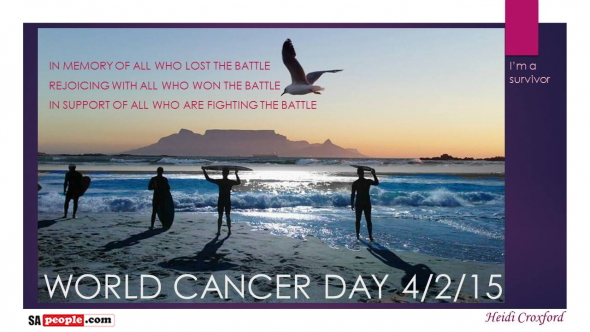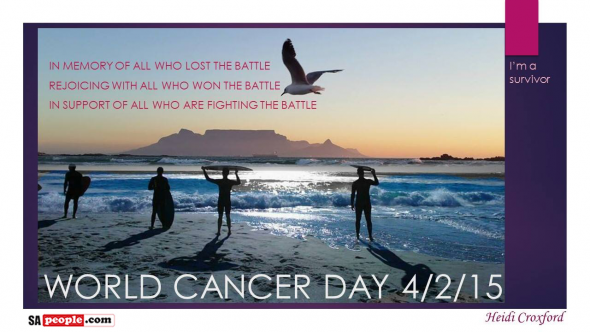
She was diagnosed with cancer. Now she’s Dancing in the Rain…
For World Cancer Day today (4 February 2015), we thought we’d share one of our favourite South African videos ever – the morning that 36-year-old mom Gerdi McKenna’s friends and family surprised her with the ultimate act of love after she’d been diagnosed with breast cancer…but then Gerdi sent us a message that’s even better […]

For World Cancer Day today (4 February 2015), we thought we’d share one of our favourite South African videos ever – the morning that 36-year-old mom Gerdi McKenna’s friends and family surprised her with the ultimate act of love after she’d been diagnosed with breast cancer…but then Gerdi sent us a message that’s even better than her video…

World Cancer Day’s aim is to raise awareness and turn the tide on this illness which claimed 14-million new cases in 2012, and which is expected to increase by about 70% over the next two decades.
This year’s theme is ‘Not Beyond Us’ and highlights the solutions that do exist, the positive and proactive steps that are being taken. And Gerdi’s message is exactly that…
“It’s been more than a year ago since I was first diagnosed with Stage 3 breast cancer,” says Gerdi. “It feels like yesterday when I received the horrible blow and I thought my life had come to an end…”
“Wow, looking back now, I almost can’t believe all the things I have had to endure.
“But the great news is, that I have been in remission and I feel so blessed to still enjoy my kids, husband and everything else this beautiful life has to offer!
“Today is World Cancer Day and my heart goes out to all the people fighting this dreadful disease. I pray for people having to endure chemotherapy and suffer the horrible side effects, as well as all the other treatments required to survive. I also pray for all the families and loved ones of all the cancer sufferers, that God will give them the strength to deal with it all.
“Once you have cancer, you always live with the fear that the cancer will return…and therefore lastly, I pray for all the cancer survivors for peace and serenity in their hearts.
“I leave you with these quotes:
“When you start doubting yourself, remember how far you have come.
Remember everything you have faced, all the battles you have won,
And all the fears you have overcome.
“And…
“Life isn’t about waiting for the storm to pass.
It’s about learning to dance in the rain.”
Watch Gerdi’s Family & Friends do Anything for Love…
Raising Awareness about Cancer
CANSA’s Acting CEO Elize Joubert says “World Cancer Day is important because the global cancer epidemic is huge and set to rise. Currently 8.2 million people die from cancer worldwide every year – in South Africa, more than 100,000 are diagnosed annually. This day helps us spread the word and raise the profile of cancer.”
Here are some key facts and insights from the World Health Organisation (WHO):

Key Facts
- Among men, the 5 most common sites of cancer diagnosed in 2012 were lung, prostate, colorectum, stomach, and liver cancer.
- Among women the 5 most common sites diagnosed were breast, colorectum, lung, cervix, and stomach cancer.
- Around one third of cancer deaths are due to the 5 leading behavioural and dietary risks:
– high body mass index,
– low fruit and vegetable intake,
– lack of physical activity,
– tobacco use,
– alcohol use. - Tobacco use is the most important risk factor for cancer causing around 20% of global cancer deaths and around 70% of global lung cancer deaths.
- Cancer causing viral infections such as HBV/HCV and HPV are responsible for up to 20% of cancer deaths in low- and middle-income countries (2).
- More than 60% of the world’s total new annual cases occur in Africa, Asia and Central and South America. These regions account for 70% of the world’s cancer deaths (1).
What is Cancer?
Cancer is a generic term for a large group of diseases that can affect any part of the body. Other terms used are malignant tumours and neoplasms. One defining feature of cancer is the rapid creation of abnormal cells that grow beyond their usual boundaries, and which can then invade adjoining parts of the body and spread to other organs, the latter process is referred to as metastasizing. Metastases are the major cause of death from cancer.
Causes of Cancer
The most common causes of cancer death worldwide are cancers of:
- lung (1.59 million deaths)
- liver (745 000 deaths)
- stomach (723 000 deaths)
- colorectal (694 000 deaths)
- breast (521 000 deaths)
- oesophageal cancer (400 000 deaths) (1).
Cancer arises from one single cell. The transformation from a normal cell into a tumour cell is a multistage process, typically a progression from a pre-cancerous lesion to malignant tumours. These changes are the result of the interaction between a person’s genetic factors and 3 categories of external agents, including:
- physical carcinogens, such as ultraviolet and ionizing radiation;
- chemical carcinogens, such as asbestos, components of tobacco smoke, aflatoxin (a food contaminant) and arsenic (a drinking water contaminant); and
- biological carcinogens, such as infections from certain viruses, bacteria or parasites.
Ageing is another fundamental factor for the development of cancer. The incidence of cancer rises dramatically with age, most likely due to a build up of risks for specific cancers that increase with age.
The overall risk accumulation is combined with the tendency for cellular repair mechanisms to be less effective as a person grows older.
Risk factors for cancers
Tobacco use, alcohol use, unhealthy diet and physical inactivity are the main cancer risk factors worldwide. Some chronic infections are risk factors for cancer and have major relevance in low- and middle-income countries.
Hepatitis B (HBV), hepatitis C virus (HCV) and some types of Human Papilloma Virus (HPV) increase the risk for liver and cervical cancer respectively. Infection with HIV substantially increases the risk of cancer such as cervical cancer.
How can the burden of cancer be reduced?
Knowledge about the causes of cancer, and interventions to prevent and manage the disease is extensive. Cancer can be reduced and controlled by implementing evidence-based strategies for cancer prevention, early detection of cancer and management of patients with cancer. Many cancers have a high chance of cure if detected early and treated adequately.
Modifying and avoiding risk factors
More than 30% of cancer deaths could be prevented by modifying or avoiding key risk factors, including:
- tobacco use
- being overweight or obese
- unhealthy diet with low fruit and vegetable intake
- lack of physical activity
- alcohol use
- sexually transmitted HPV-infection
- infection by HBV
- ionizing and non-ionizing radiation
- urban air pollution
- indoor smoke from household use of solid fuels.
Prevention strategies
- Increase avoidance of the risk factors listed above.
- Vaccinate against human papilloma virus (HPV) and hepatitis B virus (HBV).
- Control occupational hazards.
- Reduce exposure to non-ionizing radiation by sunlight. (UV)
- Reduce exposure to ionizing radiation (occupational or medical diagnostic imaging).
Early detection
Cancer mortality can be reduced if cases are detected and treated early. There are 2 components of early detection efforts:
Early diagnosis
The awareness of early signs and symptoms (for cancer types such as skin, cervical, breast, colorectal and oral) in order to get them diagnosed and treated at early stage. Early diagnosis is particularly relevant when there is no effective screening methods or – as in many low-resource settings– no screening and treatment interventions implemented. In absence of any early detection or screening and treatment intervention, patients are diagnosed at very late stages when curative treatment is no longer an option.
Screening
Screening aims to identify individuals with abnormalities suggestive of a specific cancer or pre-cancer and refer them promptly for treatment or when feasible for diagnosis and treatment. Screening programmes are especially effective for frequent cancer types for which cost-effective, affordable, acceptable and accessible screening tests are available to the majority of the population at risk.
Examples of screening methods are:
- visual inspection with acetic acid (VIA) for cervical cancer in low-resource settings;
- HPV testing for cervical cancer;
- PAP cytology test for cervical cancer in middle- and high-income settings;
- mammography screening for breast cancer in high-income settings.
Treatment
A correct cancer diagnosis is essential for adequate and effective treatment because every cancer type requires a specific treatment regimen which encompasses one or more modalities such as surgery, and/or radiotherapy, and/or chemotherapy. The primary goal is to cure cancer or to considerably prolong life. Improving the patient’s quality of life is also an important goal. It can be achieved by supportive or palliative care and psychological support.
Potential for cure among early detectable cancers
Some of the most common cancer types, such as breast cancer, cervical cancer, oral cancer and colorectal cancer have high cure rates when detected early and treated according to best practices.
Potential for cure of some other cancers
Some cancer types, even though disseminated, such as leukaemias and lymphomas in children, and testicular seminoma, have high cure rates if appropriate treatment is provided.
For more information about Palliative Care and WHO’s Global Action Plan – please click here.
To read Gerdi’s original story from last year, please click here.